Almost all nulliparous people probably know what stretch marks are and what they look like. After all, the appearance of stretch marks is one of the most unpleasant pregnancy companions for a woman. But the worst thing is that, unlike others, they do not disappear immediately after childbirth. Therefore, along with painful toxicosis and severe swelling, the appearance of stretch marks is something that newly pregnant women fear almost more than anything else.
In fact, stretch marks are not a fatal disease, and there is no need to be so panicky about them. But it is true that they do not disappear on their own without a trace. And in order to prevent their appearance or at least reduce their appearance, you need to know a little more about stretch marks than your experienced friends tell you.
What are stretch marks?
Experts call stretch marks stretch marks. But, despite the simple and seemingly accurate popular definition, stretch marks are tears, and not just stretches. Due to the loss of elasticity and firmness by the skin, it becomes thin and easily tears under tension, which is what happens during fetal growth. Of course, the epidermis is not completely torn, but only its inner layer. And he recovers very quickly. However, scars after ruptures still remain, which we see in the form of stretch marks.
In the initial stages of recovery, the connective tissue is permeated with capillaries, so the stretch marks have a lilac, pink or violet color. But gradually they become discolored and, unfortunately, remain exactly that way forever - white pearlescent scars that cannot even be tanned under the sun (after all, there is no melanin pigment there).
Why do stretch marks occur?
Ideally, our skin is similar in its properties to rubber: it is elastic, elastic, can stretch and easily return to its previous state. But for a number of reasons, these functions can be impaired - the skin becomes thinner and very easily tears from the inside. This is how stretch marks appear.
The occurrence of stretch marks in women is directly related to pregnancy. The uterus gradually enlarges, the fetus grows rapidly, and the skin does not always keep up with them. In addition, from the very beginning, colossal changes begin to occur in the body of the expectant mother, which is simply necessary to create conditions for bearing and giving birth to a healthy child. All these processes are “guided” by hormones. It is the change in the level of the hormones estrogen and progesterone that directly leads to the appearance of stretch marks. Because with high levels of these hormones, the release of collagen (responsible for skin density) and elastin (necessary for its easy stretching) decreases. The skin loses its ability to easily stretch and return to its previous state without damage. And this process, unfortunately, cannot be regulated.
The most important reason for the appearance of stretch marks is heredity. If your mother and grandmother had stretch marks, you are almost guaranteed to have them too. And in this sense, it doesn’t matter how big your belly is. Sometimes, a woman’s small belly leaves very noticeable marks, while another woman’s huge belly leaves none. This is the trick.
However, in addition to genetics, there are a number of other factors that contribute to the appearance of stretch marks and their increase in number. This is the quality of nutrition of a pregnant woman, the intake of vitamins, motor mode, and the rate of weight gain. The appearance of stretch marks is influenced by smoking during pregnancy, the woman’s age (young skin is more elastic), weakness of the abdominal muscles, metabolic disorders (diabetes or obesity, for example).
In addition, do not forget that stretch marks appear not only during pregnancy, but also in the first time after childbirth. We are talking about the breast: milk comes in very quickly to provide nutrition to the baby. The skin of the breast may not keep up with its rapidly increasing volumes, and connective tissue ruptures occur.
However, many of these factors can be controlled, which can significantly reduce the risk of unwanted streaks on the skin.
How to prevent stretch marks from appearing?
If your friend who gave birth boasts of the absence of stretch marks, this is not at all because she applied the most expensive cream at the stage of planning her pregnancy. She was just lucky: she had naturally elastic skin. So it will be very wrong on your part to pin your hopes on cosmetics alone: you may miss the moment. But you can’t sit idly by waiting for stretch marks to appear either. If your skin is genetically predisposed to this, you just need to try to slow down the unwanted processes. Like, in principle, any pregnant woman. But in case of predisposition, efforts need to be tripled.
Stretch marks on the legs during pregnancy are a common occurrence among expectant mothers, which is a problem for many women. Questions arise as to why such reactions occur on the skin and how to get rid of them.
Reasons for appearance
The very origin of stretch marks or stretch marks is explained by thinning of the skin, or rather the upper layer of the epithelium. The finest collagen fibers are torn, microcapillaries are injured, which leads to first pale pink and then blue stripes and stains on the legs and other parts of the body. Over time, these microtraumas are scarred and if the damage was deep, the tissues were not able to fully recover, then quite noticeable deep marks are formed.
Stretch marks on the legs during pregnancy, as well as on the chest, abdomen and other areas, appear for various reasons, but the main ones include:
- Hormonal changes in the body. The sensitivity of the dermis increases, an excess of progesterone affects muscle tone, including in the thighs, legs, and buttocks.
- Weight gain. Weight gain during pregnancy is an inevitable process, and the changes affect the entire body. The skin does not have time to adapt to such reactions and begins to stretch, become thinner, and become injured.
- Swelling. It is typical for the legs, since the swelling often extends to the lower limbs. This also leads to stress on the skin and the formation of stretch marks.
- Deficiency of collagen, vitamin E and some other compounds that support the structure of the skin, its elasticity, firmness, and ability to regenerate (renewal).
- Little physical activity. Lack of movement leads to weakened blood circulation and deterioration of tissue nutrition. This negatively affects many processes, including metabolic reactions within the epidermis and the condition of the muscles.
One of the provoking factors is considered to be heredity, on which the structure of the skin and its type largely depend. If close relatives have had such a problem, then it is better to immediately take preventive measures at the very beginning of pregnancy.
How to get rid of stretch marks on legs?
If red stretch marks have already appeared on the legs during pregnancy, then it is not possible to immediately stop their formation or completely eliminate them. You should start with procedures that support the skin so that the stretch marks do not become deeper, since it will be even more difficult to correct the scars.
Until the baby is born, you can practice the following methods to combat stretch marks on the legs:
- Use of cosmetics. There are various brands of creams, oils, masks and scrubs on the market that do not contain aggressive components and are designed specifically for pregnant women. As an option, use folk recipes, for example, a mixture of natural oils, coffee scrubs and other natural ingredients.
- Light massage, rubbing the feet with nourishing ingredients. This will improve blood circulation, and the beneficial components contained in the supplement will nourish the skin.
- Use of special underwear, compression stockings.
- Gymnastics for expectant mothers. Proper muscle training will help prevent stretch marks between the legs during pregnancy, strengthen the ligamentous apparatus, and prepare the entire body for the upcoming birth.
The above measures are an excellent prevention of stretch marks and help eliminate already formed microstriae.
Treatment of stretch marks after childbirth
When the baby has already appeared, the lactation period has begun, there is no need to stop skin care. Nourishing, moisturizing creams are also used, but only with the composition approved for breastfeeding. Massages, wraps, baths, scrubs - all this has a positive effect on the skin of the feet. Don't forget about proper nutrition, which is also important during lactation.
When you finish breastfeeding, you can try modern methods of aesthetic surgery. This is advisable for deep or extensive lesions, when stretch marks are really noticeable on the legs.
Common procedures for getting rid of stretch marks include the following:
- Laser exposure. Aimed at improving the regenerative reactions of tissues, which allows eliminating dermal defects in a short time.
- Microcurrent therapy, carried out under the influence of low voltages.
- Injections of collagen, activators of metabolic reactions, mesotherapy.
- Chemical peeling.
- Microdermabrasion or a kind of polishing of the upper layers of the epidermis.
It is sometimes difficult to completely get rid of stretch marks during pregnancy if the body is weakened and the skin has not received special care. Therefore, expectant mothers already in the first trimester need to choose the most suitable cosmetic product, monitor not only their health, but also pay attention to the condition of their skin and nails.
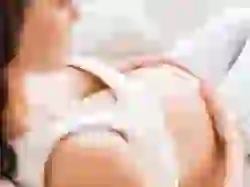
Pregnancy is the most exciting and touching state in a woman’s life. But along with the joys of new discoveries and the expectation of a miracle, specific problems arise. Specifically, skin changes such as stretch marks. You need to take care of yourself in advance so that after giving birth you still feel attractive. We will tell you what causes stretch marks and what you can do during pregnancy and after childbirth.
Stretch marks (striae) are internal scars of the skin, they arise due to stretching of the skin, the upper layer of skin (epithelium) does not keep up with the growth of the abdomen, elastin fibers are torn and replaced by scar tissue. It is difficult to predict the appearance and type of stretch marks.
The skin consists of three layers: the epidermis (the upper, constantly renewed layer), the dermis (a dense connective tissue frame, a kind of “mesh” that provides firmness and elasticity of the skin) - stretch marks appear in it, subcutaneous fatty tissue (adipose tissue, expressed in all to varying degrees).
Causes of stretch marks during pregnancy
1. Rapid growth of the abdomen.
Rapid growth of the abdomen may be a physiological change, or it may indicate excessive weight gain, polyhydramnios, or the formation of a large fetus. Your doctor will tell you how natural the changes in the body are; do not hesitate to ask about an exciting question.
2. Changes in hormonal levels.
During pregnancy, a woman's body must maintain high levels of progesterone, as this is the hormone that maintains pregnancy. Progesterone has a relaxing effect on smooth muscles, preventing the uterus from becoming toned. But along with the relaxation of the myometrium, the tone of all muscles decreases and the connective tissue of the dermis is weakened. The growing belly often outpaces the skin's ability to stretch, and tears form in the middle layer of the skin.
3. Poor nutrition before and during pregnancy.
An unbalanced diet is an insufficient intake of minerals, vitamins, protein and vegetable fats and an excess of carbohydrates and salt. In addition to the risk of gaining excess weight, a diet that often contains carbonated drinks, chips, processed foods, excess sugar, alcohol and fast food has a direct damaging effect on the skin. First of all, the synthesis of new collagen fibers in the dermis suffers.
4. Heredity.
Genetic predisposition can be traced very often; the point here is the inheritance of skin type (density, level of sebum production, ability to regenerate). It happens that a woman with a large belly during pregnancy, after the birth of a large baby or twins, has almost no skin changes. And the mother, who had a small belly throughout her pregnancy, is upset because of multiple bright stretch marks. Pay attention to similar changes in close relatives (mother, sister, aunt), ask. This will most likely help predict these changes.
5. Smoking.
In women who smoke, the synthesis of collagen and elastin is impaired, the skin is more “fragile” and the risk of stretch marks increases.
6. Age.
Primigravidas aged after 30 and under 18 years are at greater risk of getting unpleasant skin changes, since in the first case the synthesis of collagen is already somewhat slowed down, and in the first case the exchange of female hormones may not yet be stable.
7. Parity of births.
In multiparous women, changes in the skin of the abdomen are, of course, more pronounced. The break between births also matters. From many points of view, the optimal interval is a period of 2 years. During this time, the balance of hormones is restored, reserves of iron, calcium and other nutrients are replenished.
8. Concomitant diseases.
Obesity is a chronic metabolic disorder. The manifestation of the disease will be not only excess weight, but also impaired skin nutrition.
Also at greater risk are women who had stretch marks before pregnancy, childhood or adolescence (for example, due to hypothalamic syndrome).
Diabetes mellitus types 1 and 2 are also metabolic diseases. Due to increased blood sugar levels, collagen synthesis is disrupted, the skin becomes thinner, drier and much more easily damaged. The regenerative (restorative) abilities of the skin are also reduced.
Systemic diseases (systemic scleroderma, systemic lupus erythematosus and others), dermatitis, psoriasis cause specific changes in the skin, and also reduce its elasticity and regenerative abilities.
9. Motor mode.
A sedentary lifestyle reduces the delivery of oxygen to all tissues of the body. Physical inactivity also threatens excessive weight gain and fetal hypoxia.
10. Weakness of the muscles of the anterior abdominal wall.
Insufficiently trained muscles do not create a “muscle corset” and pressure on the skin from the inside increases.
11. Lactation.
We talk a lot about stretch marks on the skin of the abdomen and thighs and forget about the breasts, and meanwhile, active lactation can provoke such changes on the skin of the mammary glands. Especially in the first weeks after childbirth, when milk arrives, the skin of the breast experiences significant stress.
How do stretch marks appear in pregnant women?
Location of stretch marks according to frequency of occurrence: abdomen, breasts (breast enlargement during pregnancy and lactation is individual), hips and buttocks (physiological increase in fat layer is intended by nature for the normal exchange of female hormones, in particular estrogen, but weight gain is not always and not for everyone corresponds to the needs of the body), calves (stretch marks form here very rarely, mainly in women with severe swelling that cannot be treated for a long time).
Stretch marks can be pink, dark and light purple, or red in color and vary in width and length. From small narrow and light pink stripes in the lower abdomen or on the chest to wide dark purple stripes along the entire anterior abdominal wall and thighs. The critical period for the appearance of stretch marks on the abdomen and thighs is the third or fourth month of pregnancy, on the chest - the lactation period, on the legs - the postpartum period, when swelling decreases.

After childbirth, stretch marks gradually fade, become denser in texture and acquire a light silvery, white color. These changes do not completely disappear, but with proper care, skin tone is restored and stretch marks become less noticeable. Stretch marks do not tan because they are scar tissue and do not produce the pigment melanin.
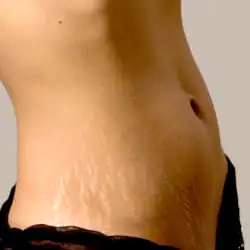
Prevention of stretch marks during pregnancy
Prevention of stretch marks should begin before pregnancy. Elastic, moisturized skin is much less susceptible to damage and has a greater ability to regenerate.
1. Normalization of weight.
You must control your weight independently and regularly; it is not recommended to gain more than 14 kilograms during pregnancy, and the risk of stretch marks increases with a sharp jump in weight.
2. Balanced nutrition.
In addition to weight control, a proper diet is designed to saturate the body with enough protein and vitamins. It is protein that helps the skin renew itself and maintains its elasticity.
It is recommended to include: vegetable oils, cottage cheese, chicken, turkey, eggs, cheese, beef, nuts, legumes. Also useful are foods rich in potassium (raisins, dried apricots, banana, pears) and an optimal drinking regime (still mineral water, natural fruit drinks, green tea up to 2 liters a day, if you have not been advised to limit fluids).
But flour, sweet and carbonated drinks should be excluded or significantly limited.
You should also take multivitamin complexes for pregnant women; they contain an optimal combination of vitamins and microelements and are easily absorbed.
3. Regular dosed physical activity.
Of all types of physical activity, walking and swimming are most suitable for pregnant women. There is also a special direction - fitness for pregnant women, it includes lightweight versions of physical training complexes, but, nevertheless, is effective for strengthening the muscular system. Find out from your doctor and, if there are no contraindications, start exercising. Classes can also be held at antenatal clinics.
If you want to practice at home, then use the following complexes, but first show them to your doctor. Classes are indicated after 12 weeks; in the first months the load should be minimized.
It is better to start classes accompanied by a spouse who can insure you.
Positional gymnastics for stretch marks
- cat pose: standing on all fours, smoothly round your back and lower your head down, and then arch your back and raise your head, repeat 10-12 times depending on how you feel
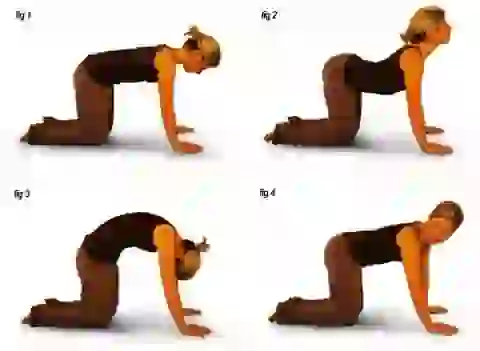
- butterfly pose: sit on the floor, bring your feet together with the soles of your feet and move them as close to you as possible, gently press on your knees with your palms and swing, as if making a “butterfly wings” movement

— twisting: while sitting or standing, rotate your torso left and right at a comfortable angle, while your pelvis remains motionless
Exercises with fitball (gymnastic ball)
- sit down in Turkish style and take the ball in your hands, raise it to the level of your face and begin to squeeze rhythmically with your palms, repeat 10-15 times (the muscles of the chest and arms are strengthened)
— we lie on our backs, legs are bent, the right one rests on the floor, and the left one stands on the ball, “roll” the ball with the left foot and return it to the starting position. For each leg, 6-10 repetitions.
- lie on your back, bent legs rest on the floor, then raise your left leg and rotate your foot to the right and left in turn, then repeat with the right leg
4. Wearing anatomical underwear for pregnant and lactating women, bandages.
Special underwear creates a soft but dense uniform compression, preventing the fabrics from sagging and stretching unnecessarily, does not cut into the skin and should be made of hypoallergenic, natural materials. You should start thinking about wearing such underwear from 12-14 weeks of pregnancy.

Wearing prenatal bandages is also recommended. The bandage should be purchased at an orthopedic pharmacy and the abdominal circumference should be measured first. The growth of the abdomen depends on many factors, and each woman may need a bandage at a different time, but on average, wearing it is indicated from 21 weeks.
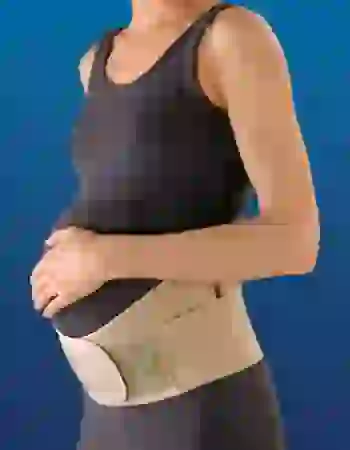
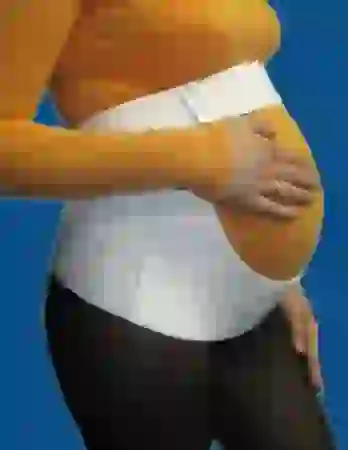
5. Massage.
Daily gentle massage prevents the appearance of stretch marks and has a general strengthening effect on the body. It consists of two stages:
- massage in the shower, the jet should make circular movements on the skin of the abdomen, chest and thighs, you should alternate cool (not cold!!) water with warm water, the period of exposure to warm water should be three times longer than cool water, a circular massage with a washcloth is also used -a mitten made of natural materials (loofah, sisal).
- massage using various creams and oils approved for pregnant women, performed on damp skin, using gentle circular movements.
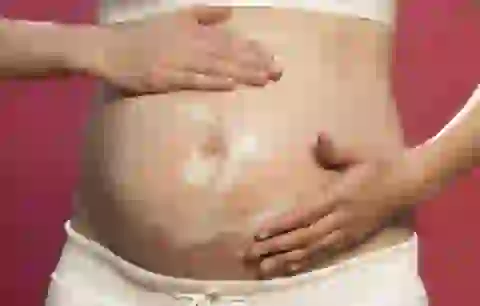
The cosmetic products you use must be purchased at a pharmacy, labeled “hypoallergenic” or “allergen tested” and approved for use by pregnant and lactating women, and it would also be a good idea to require a hygiene certificate and a quality certificate.
You can use creams for stretch marks from the brands MamaComfort, Vichy, Avent, Sanosan, ChiccoMammaDonna, Clarins, Bioterm, Vitex FOR MOTHER, World of Childhood, GreenMama.
If you do not want to use industrial cosmetics, you can massage with heated olive, peach, almond oils or jojoba, cocoa, and grape seed oils.
If you are using oil, cream, gel or emulsion for the first time, then perform an allergy test, apply a small amount of the product to the elbow and observe for about 2 hours, if no redness, swelling, or itching appears, then you can safely use it.
Massage is contraindicated for women whose pregnancy is under threat of miscarriage, as it additionally stimulates the muscles.
6. Breathing exercises.
As a result of proper breathing exercises, the body is saturated with oxygen, which has a positive effect not only on the skin. You can alternate between gymnastic exercises and breathing exercises. Consult your doctor before starting this method.
Treatment of stretch marks after pregnancy
If faded stripes still prevent you from living and feeling attractive, then use the services of a cosmetologist. The most effective fight against stretch marks is up to 1 year of age, after which the fight becomes more difficult. Most methods can be used while breastfeeding, but still consult your gynecologist. The following methods are used:
1. Laser therapy.
Using a laser beam, the upper layers of the skin are polished and the color and structure are evened out; the procedure is performed under anesthesia.
2. Mesotherapy.
The essence of the procedure is that various drugs are injected into the skin around and in the stretch area. A very thin needle is used and solutions are injected to a depth of 3-5 mm. Most reviews are positive.
3. Microdermabrasion.
Grinding the skin using a special device, the effect will be noticeable quite quickly, but the trauma to the skin with this method is significant.
4. Microcurrent therapy.
Exposing the skin to currents of up to 1000 microamps increases blood flow and helps the skin renew itself. In addition to stretch marks, this method is used to treat acne and age spots that complicate pregnancy. Treatment, of course, after delivery.
5. Chemical peeling.
Applying a chemical composition (most often including fruit acids) to the skin, which causes the top layer to peel off and thereby even out the tone and structure. After the procedure, a superficial skin burn occurs and a recovery period is required. The method is not used in the sunny season, since irradiation causes persistent pigment spots to develop.
6. Ozone therapy.
Many injections with an oxygen-ozone mixture are made into the affected area. Metabolism improves and the production of new cells is stimulated.
7. Abdominoplasty.
The most radical method consists of removing damaged areas of skin and suturing the defect.
In addition to salon procedures, you continue self-massage and the use of specialized creams and oils.
Forecast
Stretch marks are a cosmetic nuance that does not threaten you and your baby in any way, so if you have already acquired such changes (like most women), then do not be upset or obsess over it. Over time, the stretch marks will fade significantly and will not be noticeable. Maintain a normal weight, apply our tips, because at any stage you can improve your skin condition.
And remember “the most beautiful of women is a woman with a child in her arms”!



